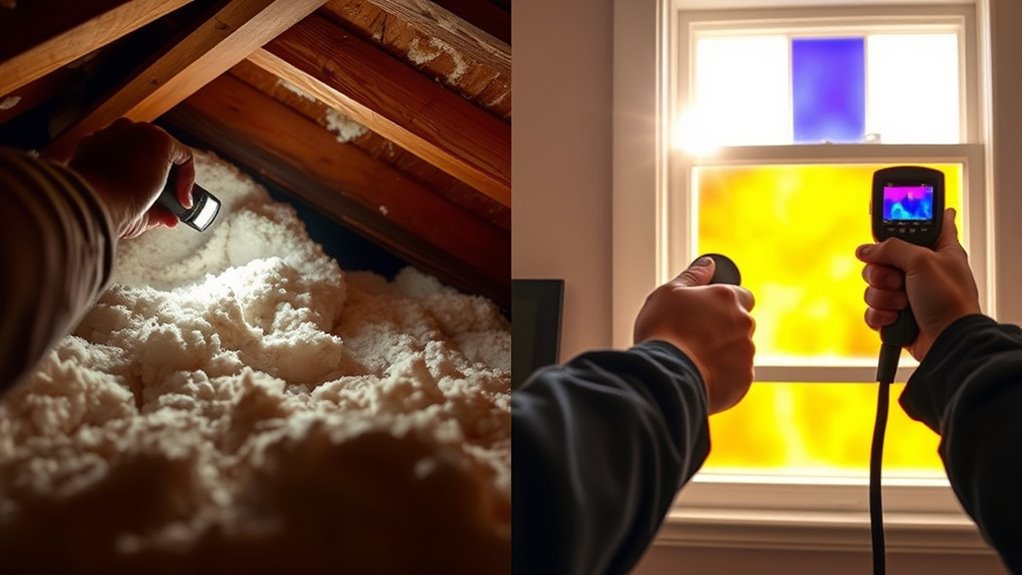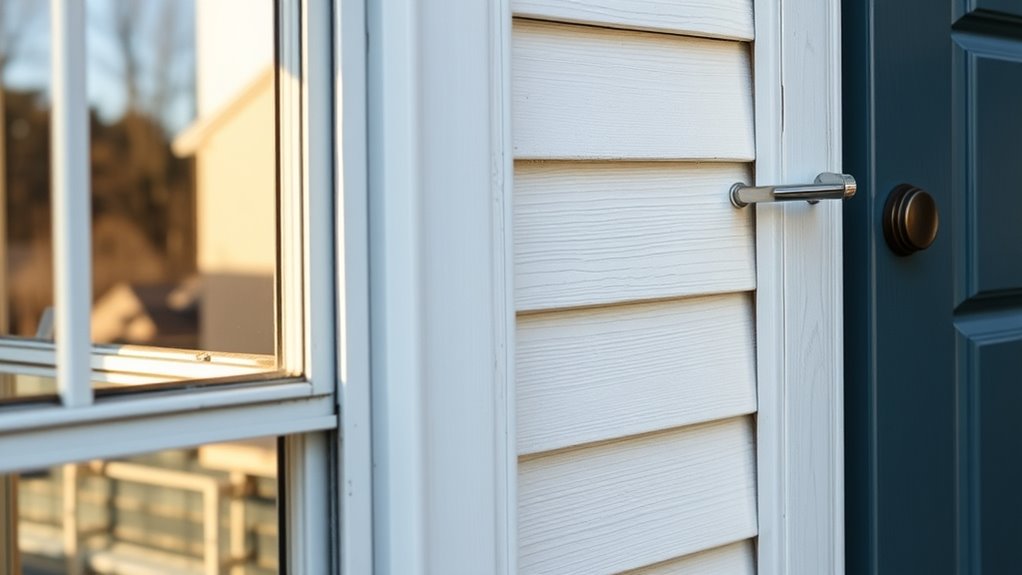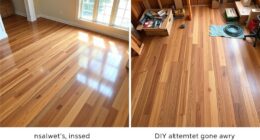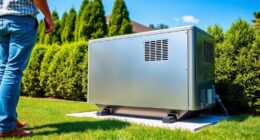Before installing a heat pump, focus on weatherizing your home by sealing gaps around windows, doors, and vents with weatherstripping and caulk. Prioritize insulating your attic, walls, and floors — especially over unconditioned spaces — to prevent heat loss. Conduct blower door tests to identify leaks and improve airtightness. Combining insulation with air sealing increases efficiency and comfort. Keep exploring for more tips to get the most out of your new heat pump system.
Key Takeaways
- Prioritize attic insulation, especially in the attic, to prevent heat loss and improve heat pump efficiency.
- Seal gaps around windows, doors, electrical outlets, and vents with weatherstripping and caulk.
- Conduct blower door tests to identify leaks and ensure airtightness throughout the home.
- Insulate floors over unconditioned spaces like basements or crawl spaces for temperature stability.
- Use dense-pack cellulose or spray foam insulation for filling gaps and creating continuous barriers.

Preparing your home for different weather conditions can save you money and keep your family comfortable year-round. Before installing a heat pump, it’s essential to focus on improving your home’s energy efficiency through insulation upgrades and air sealing techniques. These steps guarantee your new system works effectively, reducing energy waste and lowering your utility bills over time. Proper insulation keeps warm air in during winter and cool air in during summer, making your space more comfortable. Upgrading your attic, walls, and floors with high-quality insulation minimizes heat transfer, so your heat pump doesn’t have to work as hard to maintain a consistent temperature.
Air sealing is equally important. Small gaps and leaks around windows, doors, electrical outlets, and vents can cause considerable energy loss. By implementing air sealing techniques, you prevent drafts that can undermine your heating and cooling efforts. Use weatherstripping on doors and windows, caulk around window frames, and seal gaps around pipes and vents to block unwanted airflow. These measures help create a tighter building envelope, making your home more energy-efficient and boosting the effectiveness of your heat pump.
Start by inspecting your home’s current insulation levels and identify areas where improvements are needed. Adding insulation in the attic is often the most cost-effective upgrade, as heat naturally rises and escapes through the roof. Consider dense-pack cellulose or spray foam insulation to fill gaps and create a continuous barrier. For walls, blown-in insulation can be a quick, non-invasive option if you’re not ready for major renovations. Don’t forget to insulate floors over unconditioned spaces like basements or crawl spaces, which can substantially impact temperature stability.
Simultaneously, focus on air sealing to eliminate drafts. Conduct a blower door test if possible, to identify leaks you might not see. Seal leaks with appropriate materials—caulking for small cracks and foam sealants for larger gaps. Pay special attention to areas around electrical outlets, switches, and plumbing penetrations, as these are common sources of air leaks. After sealing, add weatherstripping to doors and windows to further improve airtightness. Understanding sound design principles can also help in creating quieter, more comfortable indoor environments by reducing noise infiltration from outside.
Frequently Asked Questions
How Can I Determine if My Home Is Suitable for a Heat Pump?
You can ascertain if your home is suitable for a heat pump by starting with an energy audit, which assesses your current efficiency and heating needs. Also, check your insulation to guarantee it’s adequate; poor insulation can reduce heat pump effectiveness. Address any gaps or leaks first, as these issues impact performance. If your home scores well in these areas, it’s likely a good candidate for a heat pump upgrade.
What Safety Precautions Should I Take During Weatherization?
Think of safety gear as your armor when weatherizing your home. You should always wear gloves, goggles, and a mask to protect against dust and chemicals. Make certain proper ventilation measures are in place to avoid inhaling fumes or spreading dust. Turn off power sources before starting work, and keep a fire extinguisher nearby. These precautions safeguard you, making the process safe and efficient as you prepare your home for a heat pump.
Are There Specific Insulation Types Recommended for Heat Pump Efficiency?
You should focus on using insulation materials like spray foam, fiberglass, or mineral wool, which effectively improve your heat pump’s efficiency. Make certain you install thermal barriers such as reflective foil or rigid foam boards to minimize heat loss. Proper insulation reduces energy consumption and maintains consistent indoor temperatures. By selecting the right insulation types and ensuring they’re correctly installed, you’ll maximize your heat pump’s performance and savings.
How Long Does Weatherization Typically Take Before Installing a Heat Pump?
The weatherization process can take anywhere from a few days to a couple of weeks, depending on your home’s condition. You’ll start with insulation upgrades, sealing ducts tightly to prevent energy loss, and ensuring your home is airtight. This prep work is essential for maximizing your heat pump’s efficiency. Stay patient—you’ll soon enjoy the comfort and savings that come with a well-weatherized home and a properly installed heat pump.
Can Weatherization Be Done DIY or Should I Hire a Professional?
You can attempt DIY weatherization, but be aware of the challenges involved. DIY challenges include ensuring proper sealing, insulation, and ventilation, which can affect your heat pump’s efficiency. For best results, you should hire a professional who has the expertise to identify and fix issues accurately. Professionals bring the necessary knowledge, tools, and experience, ensuring your home is properly weatherized and ready for your heat pump installation.
Conclusion
Before installing your heat pump, weatherize your home to unleash its full potential. Think of your home as a cozy garden—without proper protection, even the best plants struggle to thrive. Sealing leaks and insulating walls act like a sturdy fence, keeping the warmth in and the cold out. When your home’s weatherproofed, your new heat pump can work more efficiently, saving you money and ensuring comfort all year round. Ready to make your home a fortress of warmth?








